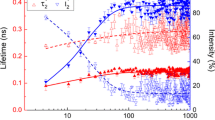Abstract
Tin-vacancy interaction was studied in a dilute Al(Sn) alloy, quenched from 613°C to −70°C and isochronally heat treated up to 250°C, using parallel positron lifetime and Mössbauer spectroscopy.
For the interpretation of the results, a simple model was developed including tin-monovacancy tin-divacancy and tin-tetravacancy complexes as well as more complicated tin-vacancy agglomerates as important participants of the recovery process. According to this model, the changes observed in the positron lifetime and Mössbauer spectra can be explained by the gradual transformation of these complexes to simpler ones through transitional configurations.
Only two lines could be observed in the Mössbauer spectra and the results suggest that a single vacancy has minor effect on the isomer shift of the line corresponding to tin in substitutional lattice site.
Similar content being viewed by others
References
Cs. Szeles, K. Süvegh, Z. Homonnay and A. Vértes, phys. stat. sol. (a) 103(1987)397.
L. F. Mondolfo ed., “Aluminium Alloys: Structure and Properties”, London, Butterworths (1976).
K. O. Sørensen and R. M. J. Cotterill, Acta Met., 22(1974)1331.
S. Umeyama, M. Taniwaki, I. Ishida and M. Kato, J. Phys. (Paris) Colloq. 40(1979)C2–539.
A. Vértes, Cs. Szeles, M. Z. Awad and S. Nagy, Scripta Metall., 16(1982)1229.
J. W. Petersen, S. Damgaard and G. Weyer, J. Phys. F11(1981)487.
I. Tanaka, S. Nasu, F. E. Fujita, F. Ambe, S. Ambe and I. Okada, J. Phys. F16(1986)L151.
M. Taniwaki, S. Umeyama and Y. Ishida, in “Point Defects and Defect Interactions in Metals”, ed: J. Takamura, M. Doyama and M. Kiritani, University of Tokyo Press (1982)477.
H. Mehner, J. Juhász, M. Suba and A. Vértes, Radiochem. Radional. Letters 56(1982)57.
B. Bergersen and M. J. Scott, Solid State Commun. 7(1969)1203
M. J. Puska and R. M. Nieminen, J. Phys. F13(1983)333.
R. W. Siegel, J. Nucl. Mater. 69/70(1978)117.
Author information
Authors and Affiliations
Rights and permissions
About this article
Cite this article
Homonnay, Z., Süvegh, K., Szeles, C. et al. Mössbauer and positron annihilation study of tin-vacancy interaction during the recovery of a dilute Al−Sn alloy. Hyperfine Interact 45, 389–396 (1989). https://doi.org/10.1007/BF02405904
Issue Date:
DOI: https://doi.org/10.1007/BF02405904




